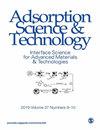Adsorption-Desorption Surface Bindings, Kinetics, and Mass Transfer Behavior of Thermally and Chemically Treated Great Millet Husk towards Cr(VI) Removal from Synthetic Wastewater
IF 2.8
4区 工程技术
Q2 CHEMISTRY, APPLIED
引用次数: 11
Abstract
This study reports the efficacy of adsorbents synthesized by thermal (TT-GMH) and chemical (CT-GMH) modification of great millet husk (GMH) for the treatment of synthetic wastewater containing Cr(VI). The chemical modification of raw GMH was done by concentrated H2SO4 to increase the porosity and heterogeneity on the surface. The comparative investigations of physicochemical properties of synthesized adsorbents were examined by point of zero charge (pHpzc), BET surface area, SEM-EDX, FTIR, and XRD analyses. The results revealed that CT-GMH had around three times higher surface area and more porous structure as compared to TT-GMH. The adsorption experiments were executed in batch mode to examine the impact of parameters governing the adsorption process. For Cr(VI) solution of 25 mg/L, adsorbent dose of 4 g/L, temperature of 25 ° C , and shaking speed of 150 RPM, the maximum removal for TT-GMH was attained at pH 1 and contact time 150 min, while for CT-GMH, maximum removal was attained at pH 2 and contact time 120 min. The experimental results fitted to the rate kinetic equations showed that for both TT-GMH and CT-GMH, adsorbents followed the quasi-second-order kinetic model during the adsorption process. Further, results revealed that the adsorption process was endothermic and Sips isotherm model was followed for both TT-GMH and CT-GMH. Based on the Sips isotherm, maximum uptake capacity for TT-GMH and CT-GMH was noted to be 16 and 22.21 mg/g, respectively. Among the tested mass transfer models, liquid film diffusion model was followed during the adsorption process of both the adsorbents. The desorption study revealed that TT-GMH and CT-GMH give 69.45% and 74.48% removal, respectively, up to six cycles.热处理和化学处理大谷壳对合成废水中Cr(VI)的吸附-解吸表面结合、动力学和传质行为
本研究报道了大谷壳(GMH)的热(TT-GMH)和化学(CT-GMH)改性合成的吸附剂对含Cr(VI)的合成废水的处理效果。用浓硫酸对原料GMH进行化学改性,以增加表面的孔隙率和不均匀性。通过零电荷点(pHpzc)、BET表面积、SEM-EDX、FTIR和XRD分析对合成的吸附剂的物理化学性质进行了比较研究。结果表明,与TT-GMH相比,CT-GMH具有大约三倍高的表面积和更多的多孔结构。吸附实验以分批模式进行,以检验控制吸附过程的参数的影响。对于25的Cr(VI)溶液 mg/L,吸附剂剂量为4 g/L,温度25°C,摇动速度150 RPM,TT-GMH的最大去除率在pH下达到 1和接触时间150 分钟,而对于CT-GMH,在pH下达到最大去除率 2和接触时间120 min。与速率动力学方程拟合的实验结果表明,对于TT-GMH和CT-GMH,吸附剂在吸附过程中都遵循准二阶动力学模型。此外,结果表明,TT-GMH和CT-GMH的吸附过程是吸热的,均遵循Sips等温线模型。根据Sips等温线,TT-GMH和CT-GMH的最大吸收能力分别为16和22.21 mg/g。在测试的传质模型中,两种吸附剂在吸附过程中均遵循液膜扩散模型。解吸研究表明,TT-GMH和CT-GMH在长达六个循环的过程中分别去除了69.45%和74.48%。
本文章由计算机程序翻译,如有差异,请以英文原文为准。
求助全文
约1分钟内获得全文
求助全文
来源期刊

Adsorption Science & Technology
工程技术-工程:化工
CiteScore
5.00
自引率
10.30%
发文量
181
审稿时长
4.5 months
期刊介绍:
Adsorption Science & Technology is a peer-reviewed, open access journal devoted to studies of adsorption and desorption phenomena, which publishes original research papers and critical review articles, with occasional special issues relating to particular topics and symposia.
 求助内容:
求助内容: 应助结果提醒方式:
应助结果提醒方式:


